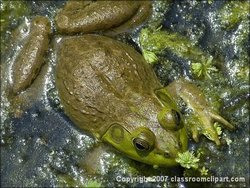Frog
|
|
Frogs are amphibians in the Order Anura, which includes frogs and toads. The term "frog" is a popular nomer for animals that look like toads, but are generally more slender, have a less warty and dry skin, have long legs adapted for leaping and are more aquatic. It has no meaning in animal systematics, since many anuran families include both "frogs" and "toads". The true frogs are the Ranidae and the true toads are the Bufonidae.
| Contents |
Characteristics
Frogs range in size from less than 50mm (2.0 in) to 300mm (11.8 in) in Conraua goliath, the Goliath frog from Cameroon, which is the largest known frog. Frogs can have horizontal pupils, like tree frogs and true frogs, or vertical pupils, like the painted frogs.
The skin is smooth, unkeratinized and hangs loosely on the body because of the lack of loose connective tissue.
Generally, frogs have long legs with webbed toes. The true frogs have a tongue with two lobes on its free end; it is attached in front. Frogs have three eyelid membranes: one transparent to protect the eyes underwater, and two which are translucent to opaque like human eyelids. They have a tympanum on each side of their head, which is involved in hearing.
Croaking
Many species of frog (and toad) have deep calls, or croaks. Frog noise tends to be spelt (for English speakers) as "crrrrk" in Britain and "ribbit" in the USA. This difference is due to Britain and the USA having different species of frogs (e.g. Rara temporaria in Britain and Rana pipiens (leopard frog) etc in the USA.) The croak of the American bullfrog Rana catesbiana is sometimes spelt "jug o' rum". The Ancient Greeks (for example Aristophanes) spelt the croak of the usual Greek species of frog as "korax" or "brekekekex co-ax co-ax": that species is probably Rana ridibunda. Small tropical frogs tend to have higher-pitched calls. Rigveda book 7 hymn 103 describes frogs with different calls (gomāyu = "having a voice like a cow's" and ajamāyu = "having a voice like a goat's") calling when the rains bring the breeding season.
Some species of frog secrete toxins from their skin. These toxins deter predatory animals from eating them, and some are extremely poisonous to humans. Some natives of the Amazon area extract poison from the poison dart frog and put it on their arrowheads when hunting.
Distribution and status
Members of this family are found worldwide, but they have a limited distribution in South America and Australia. They do not occur in the West Indies, nor on most oceanic islands.
In many parts of the world the frog population has declined drastically over the last few decades. Pollutants are one cause for this decline, but other culprits include climatic changes, parasitic infestation, introduction of non-indigenous predators/competitors, infectious diseases, and urban encroachment.
Frog zoology
Main Article: Frog zoology
Life cycle
The life cycle of a frog involves several stages. Typically adult frogs gather in suitable pools, the first to arive usually being the males. Their croaking may well encourage the females to arrive. A female would wish to avoid arriving at a pond which did not have any males in attendance. Gravid female frogs are actively and persistently sought out by males and many males will often try to attach themselves to a single female but eventually one male will secure possession. Amplexus is the process wherein the male grasps the female while she lays her eggs. At the same time, he fertilizes them with a fluid containing sperm. The eggs are about 2.0 to 2.8 millimetres in diameter and are dark brown and are covered in an outer shell of gelatinous transparent material which swells in contact with water. The female frog lays her eggs in a shallow pond or creek, where they will be sheltered from the current and from predators. The eggs, known as frogspawn hatch into tadpoles. The tadpole stage develops gradually into a froglet, resembling an adult but retaining a vestigial tail. Finally the froglet develops into an adult frog. Typically, tadpoles are herbivores, feeding mostly on algae, whereas juvenile and adult frogs are rather voracious carnivores.
Most temperate species of frog reproduce in the period between late autumn to early spring. In the UK most Common Frog populations produce frogspawn in February although there is wide variation in timing. Water temperatures at this time of year are relatively low and typically between four and 10 degrees celsius. Reproducing in these conditions helps the developing tadpoles because dissolved oxygen concentrations in the water are highest at cold temperatures. More importantly, reproducing early in the season ensures that appropriate food is available to the developing frogs at the right time.
Diet
Most frogs eat insects such as mosquitoes, earthworms and small fish such as minnows; however, a few of the bigger ones may tackle larger prey, such as mice. Some frogs use their sticky tongues effectively in catching fast-moving prey. Still others capture their prey in their mouth with speed and agility. Some big frogs eat small frogs.
Predators
Many animals eat frogs. These include herons, stork, large fish, snakes otters, foxes, badgers, coatis, etc etc. Large domestic ducks are built for dredging rather than fishing, but routinely catch and swallow frogs, as commemorated in the song Froggy would a-wooing go.
Frog Clipart and Pictures
- Frog Clipart (http://classroomclipart.com/cgi-bin/kids/imageFolio.cgi?direct=Clipart/Animals/Frogs)
- Amphibian Pictures (http://classroomclipart.com/cgi-bin/kids/imageFolio.cgi?direct=Animals/Amphibians)
- Pictures of Frogs (http://classroomclipart.com/cgi-bin/kids/imageFolio.cgi?direct=Animals/Amphibians/Frogs)
Clipart and Animal Pictures
- Clipart (https://classroomclipart.com/image/category/clipart.htm)
- Animal Clipart (https://classroomclipart.com/image/category/animal-clipart.htm)
- Animal Animated Clipart (https://classroomclipart.com/clipart/Animations/Animals.htm)
- Pictures of Animals (https://classroomclipart.com/image/category/animal-photos.htm)
- Amphibian Clip Art, Pictures and Photogaphs (https://classroomclipart.com/image/category/amphibian-clipart.htm)
- Farm Animal Clip Art, Pictures and Photographs (https://classroomclipart.com/image/category/farm-animal-clipart.htm)
- Mammal Clip Art, Pictures and Photographs (https://classroomclipart.com/image/category/mammal-clipart.htm)
- Marine Animal Clip Art, Pictures and Photographs (https://classroomclipart.com/image/category/marine-life-clipart.htm)
- Reptile Clip Art, Pictures and Photographs (https://classroomclipart.com/image/category/reptile-clipart.htm)
- Spider Clip Art, Pictures and Photographs (https://classroomclipart.com/image/category/spider-clipart.htm)




